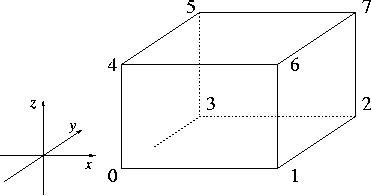
 |
Although they are represented in a canonical form by only two vertices, namely the lexicographically smallest and largest vertex with respect to Cartesian coordinates, we provide functions for ``accessing'' the other vertices as well.
Iso-oriented cuboids and bounding boxes are quite similar. The difference however is that bounding boxes have always double coordinates, whereas the coordinate type of an iso-oriented cuboid is chosen by the user.
|
| |||
|
introduces an iso-oriented cuboid c with diagonal
opposite vertices and . Note that the object is
brought in the canonical form.
| |||
| |||
|
introduces an iso-oriented cuboid c with diagonal
opposite vertices
(min_hx/hw, min_hy/hw, min_hz/hw) and
(max_hx/hw, max_hy/hw, max_hz/hw).
If the last argument
is not explicitly given, it defaults to R::RT(1). Precondition: hw R::RT(0)
| |||
|
|
| |
| Test for equality: two iso-oriented cuboid are equal, iff their lower left and their upper right vertices are equal. | ||
|
|
| |
| Test for inequality. | ||
|
|
| returns the i'th vertex modulo 8 of c. starting with the lower left vertex. |
|
|
| |
| returns vertex(i), as indicated in the figure below: | ||

|
|
| returns the smallest vertex of c (= vertex(0)). |
|
|
| returns the largest vertex of c (= vertex(7)). |
|
|
| returns smallest Cartesian -coordinate in c. |
|
|
| returns smallest Cartesian -coordinate in c. |
|
|
| returns smallest Cartesian -coordinate in c. |
|
|
| returns largest Cartesian -coordinate in c. |
|
|
| returns largest Cartesian -coordinate in c. |
|
|
| returns largest Cartesian -coordinate in c. |
|
|
| |
|
returns -th
Cartesian
coordinate of
the smallest vertex of c. Precondition: . | ||
|
|
| |
|
returns -th
Cartesian
coordinate of
the largest vertex of c. Precondition: . | ||
|
|
| c is degenerate, if all vertices are collinear. |
|
|
| |
| returns either ON_UNBOUNDED_SIDE, ON_BOUNDED_SIDE, or the constant ON_BOUNDARY, depending on where point is. | ||
|
|
| |
|
|
| |
|
|
| |
|
|
| returns the volume of c. |
|
|
| returns a bounding box containing c. |
|
|
| |
|
returns the iso-oriented cuboid obtained by applying on
the smallest and the largest of c. Precondition: The angle at a rotation must be a multiple of , otherwise the resulting cuboid does not have the same size. Note that rotating about an arbitrary angle can even result in a degenerate iso-oriented cuboid. | ||